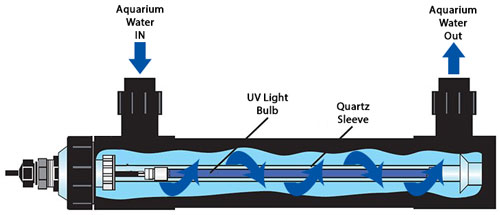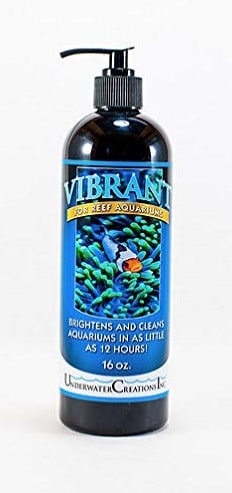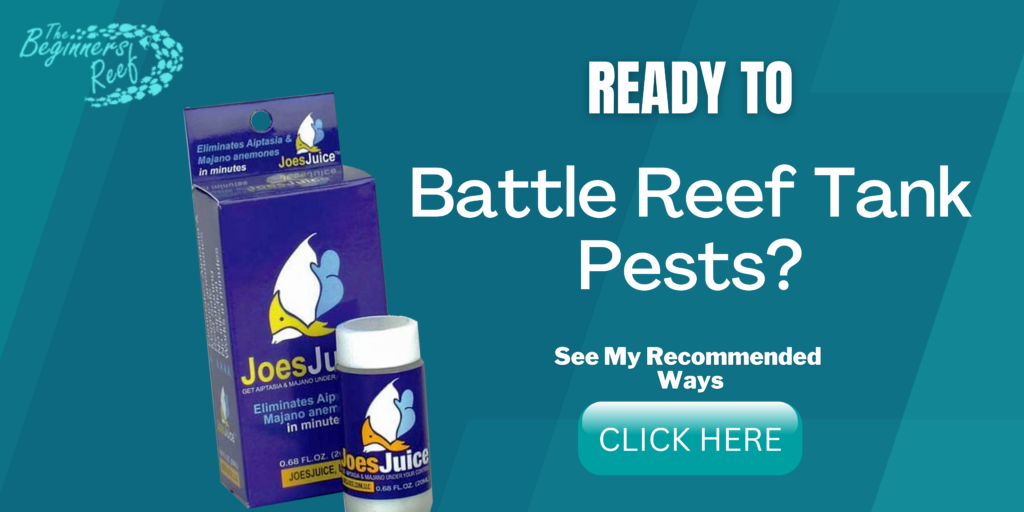Let me guess, you have set up your new saltwater aquarium, it is either in its Nitrogen Cycle or it has just finished and now all of your sand has a brown dusting all over it!
Do not worry! These are called Diatoms and are a natural part of your aquarium maturing.
I remember seeing them for the first time many, many moons ago and I couldn’t really find out any information in the books I had and it was quite frustrating – Yes, this was before the advent of the internet!
This has led to the creation of this article to help you understand what they are and what to do.
Time, Snails, a UV Filter, and RO/DI Water can all help to reduce Diatoms. Brown Diatoms are a single-celled organism that appear in an aquarium when there is an abundance of Silicate.They usually appear in the first few months of setting up a new reef aquarium and dies off once the Silicate is consumed.
The best course of action with Brown Diatom Algae is to let it run its course, but your aquarium may look gross and you want to help speed it up. Read on to find out more about Diatoms and how to get rid of these guys…
How Do You Remove & Prevent Brown Diatom Algae In Reef Tanks?
Here are several ways to remove brown diatom algae once it appears:
- Give It Time
- Increase Water Flow
- Add Algae Eating Livestock
- Manual Removal
- Chemical Treatment
To help prevent further outbreaks or reduce the severity of outbreaks use:
- Use High-Quality Water
- Add UV Filtration
- Reduce Livestock
Let’s look further into each of these methods to help you get a better understanding of each.
1. Time
This is by far the main factor in the removal of Brown Diatom Blooms. While there is a food source for the Diatoms they will continue to reproduce. A little patience and knowing it is just part of your aquarium maturing is all you need. Diatoms feed on silicates and your rock and sand are full of them in a new aquarium.
As the Diatoms consume these silicates they will eventually run their food source dry, at this point, the Diatoms will begin to die off and the outbreak or bloom will diminish and disappear.
2. Add Livestock
A slow and steady start to adding a Clean-Up-Crew (CUC) is always recommended when the aquarium cycle is complete. I really advise AGAINST heading to a store, be it online or local, and buying a ‘Reef Cleaner Package’ because once all the food is gone, they all die.
A far better way to help rid your tank of Diatoms is to gradually increase your CUC population as you see fit. To help mow down this brown film in your aquarium there are some great snails that can help feed on this stuff:
- Nerite Snails
- Certith Snails
- Margarita Snails
- Nassarius Snails
- Mexican Turbo Snails
By purchasing just one or two of each of the above species of snail will ensure all areas of your aquarium are serviced.
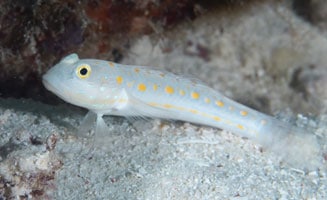
Another addition you might want to consider is a Diamond Spot Goby. These guys spend all day munching up sand and sifting it through their gills. They will help to keep the sandbed pristine, but ensure you have a lid or mesh covering your aquarium as they are notorious jumpers!
3. Increase Water Flow
Having a strong, random water flow in your aquarium is not only going to be beneficial to the coral you may eventually purchase, but it also helps to control Diatoms and other blooms like Cyano and Dino’s.
Good, strong, random flow prevents detritus and Diatom cells from settling on the sand and rock. Keeping the material suspended in the water column provides it a better chance of it passing through your filtration and being removed from the water altogether.
Detritus being allowed to settle and break down will also introduce Ammonia, Nitrates, and Phosphates into the water which just provide more food for your Diatoms and Nuisance algae. If you find you are only getting Diatoms appearing in one area, you may have a low flow zone. Try repositioning a powerhead/wavemaker to get more flow on this area, or add an additional pump to your tank to help circulate the water better.
4. Install a Reverse Osmosis/De-Ionized (RO/DI) Water Filter
Having the highest quality water is one of the best foundations your aquarium will ever have. By having an RO/DI water filter you can be sure that any pollutants, heavy metals, or toxic compounds never reach your tank.
Most aquarists beginning their aquarium always seem to purchase an RO/DI unit once the aquarium has been filled and are getting problems like this, however, if you can fill your entire aquarium and then change water using only pure RO/DI water, the problems you will face will be drastically reduced.
Adding this simple water filter to your home will save you so many problems throughout the life of your reef. Spending a few hundred bucks on a good-quailty RO/DI unit will be one of the best investments you can make in your tank!
You can find out more about RO/DI units in the ‘Further Reading’ section at the end of this article.
5. Manual Removal
Reducing the Diatom bloom any way you can is going to improve the look of your aquarium much faster. The only way to get rid of the Diatoms is to have them removed from the water.
The best ways to help get the Diatoms waterborne are daily cleaning of the glass with an algae scraper, a toothbrush for scrubbing seams, equipment and rocks and also using a turkey baster to blast water at the rock and forcing the Diatoms into the water column.
Once into the water, your filtration can do its job and remove them. The second method is to use a gravel vacuum to regularly vacuum the sand bed and physically remove them doing small but often water changes.
6. UV Filtration
UV or Ultra-Violet filters work by mutating the cells of any organism that passes by the UV bulb. By installing a UV filter on your aquarium, any Diatom cell that gets into the water column and then is passed through the UV will mutate and die.
By mutating the DNA of the cell you are preventing it from reproducing and either making the bloom more intense or stick around longer. Using a UV filter in conjunction with daily Diatom removal can drastically reduce the severity of your algae bloom and that of other algae.
For more information on aquarium UV filters please check out my article HERE
7. Chemical Treatment
Many aquarists seem to be getting very good results from a fairly new product called Vibrant Aquarium Cleaner by Underwater Creations.
Vibrant uses multiple strains of bacteria to attack the algae from different angles. One of the bacteria strains targets the Nitrates and Phosphates that feed your algae and turn them into biomass to be removed via your Protein Skimmer or water changes.
This product is also designed to work on any problem algae, according to the manufacturer.
You can read the forum thread HERE on Reef2Reef where Jeff the owner comes on and joins in the conversation regarding it! – Cool!
“Vibrant is a true beast and we have not yet come across a algae that Vibrant can not beat out. Below I will list a general timeline of how fast Vibrant works on frequent algae strains that cause issues in reef aquariums”.
Jeff Jacobson
Cloudy/hazy Water– 1 dose
Diatoms – 1-2 doses
Cyanobacteria – (Yes, it will outcompete another bacteria) 1-5 doses
Dinoflagellates – 2-5 doses
Bubble algae – 3-8 doses
Hair Algae – 3-5 doses (depending on species of hair and how bad the infestation is)
Turf Algae – 8-20 doses ( again, depending on species and how bad the infestation is)
Bryopsis – 6-30 doses ( again, depending on species and how bad the infestation is)
Owner – Underwater Creations, Inc.
This great product is getting fantastic results and the many owners in the forums are confirming this!
8. No Further Livestock Additions
Once your Diatoms have taken hold they are in the process of consuming the silicates and nitrates that fuel them. Once that food source expires so will the Diatoms. One problem that can occur is when you decide you need more sand or more rock in your aquarium months after the initial installation. Sand and rock are the two biggest sources of silicates that fuel the Diatoms and adding more will either:
- Begin another Diatom bloom
- Fuel the existing Diatom bloom and extend the time
Another problem is if you have an RO/DI water filter but you have no water stored ready to use. A sudden poisoning to the aquarium water could require a 50% water change and the only option you have is to use tap water and a de-chlorinator.
Depending on how much junk is in your city/well water, you could have now just provided more food to your Diatoms. Always try and keep a good amount of filtered RO/DI water ready for use in cases just like this.
Now that you have found out a few ways on which to remove and prevent Diatoms here is some information about what this stuff is:
What Is Brown Diatom Algae?
Brown algae in an aquairum is caused by Diatoms. They are a single-celled organism that coats sand, rock, glass, and ornaments in a brown dust-like layer. They appear in new aquariums when silicates and nitrates are highand die off once their food source is consumed. Diatom blooms last weeks to months.
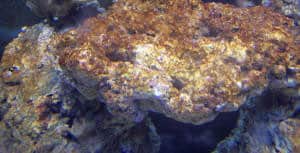
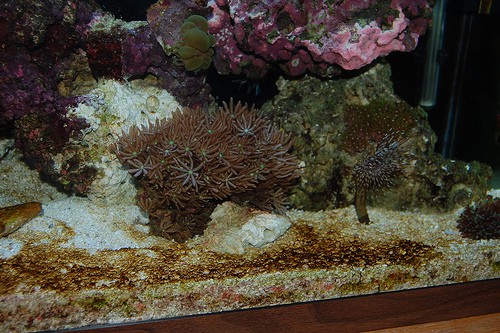
Diatoms are one of the most common organisms found in water all over the world. There are dozens of different classes and orders of Diatoms and all of them together generate around 20% of the world’s oxygen *(Wiki Link).
Most Diatoms are photosynthetic organisms meaning that they produce most of their energy by consuming Silicates, Nitrates, Phosphates and by photosynthesizing light. The silicates they consume are used to grow the outer walls surrounding the cell casuing them to appear like an algae.
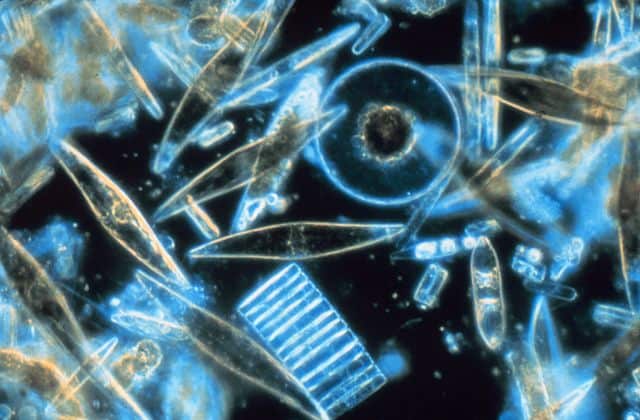
What Causes Brown Diatom Algae In An Aquarium?
Diatoms are a natural organism found Diatoms blooms when silicates are high in a new aqaurium. Silicates are present in the sand and rock and provide a food source for diatoms to radidly multiply. This is the catalyst to a diatom bloom. High nitrates, phosphates and powerful aqaurium lighting can sustain the bloom for longer periods.
As the silicate is consumed the Diatoms will die off. Using high quality sand and water can help reduce and prevent further outbreaks. In the short term increasing water flow and adding snails or sand sifting fish will help remove the Diatoms.
Here are the most common way that aquarists use to reduce the bloom or shorten its lifespan:
1. Silicate
This is the nautural element that causes the Diatoms to rear their heads. Within your aquarium, you will have a high silicate concentration during its early months. This is caused by the silicates being released by your sand and rock.
Soaking your rock in a Brute trashcan with a heater and a powerhead for months before installing in your aquarium is one way to reduce the Diatom bloom, but you will still get it, just to a lesser degree.
To be honest it is not worth the effort!
2. Aquarium Lighting
The intense lighting we need to allow our corals to flourish plays a key role in causing your Diatoms to bloom. Only a few classes of Diatoms are found deep in the world’s oceans where no light ever reaches, but the classes that grow in our aquariums are all photosynthetic and feed off the light.
The intense lights we use in our aquarium is perfect for plant-based cells to photosynthesize and having stronger light you can actually help reduce the Diatom severity by out-competing it with something else 😉
Other more prevalent and long-term residents of our home aquarium are Green Film Algae and Green Hair Algae. These are ravenous consumers of nitrates and phosphates and by having stronger lighting you will encourage more growth of these types of algae. By having more of the green algae you can starve the Diatoms of the Nitrates and Phosphates they also need to grow.
But then you have another issue of green algea unless you control it.
Therefore, by allowing the green algae to grow (which you will have in your aquarium forever, no matter what) you can help reduce the severity and longevity of your Diatom bloom.
For aquariums with lower-quality or dim lighting systems this can be the perfect environment for Diatoms to flourish as the rate of growth for the green algae is not as rapid.
There are two methods to help overcome this:
- Install higher quality, intense lighting over your aquarium
- Install a Refugium or an Algea Turf Scrubber to allow algae to grow in a controlled environment
(To find out more about each of these items click on the included links)
3. Nitrates
Nitrates begin to build at the end of your Nitrogen Cycle and as the nitrates begin to build they are providing an additional food source for the Diatoms. This is the main reason why Diatoms begin to appear several months into your new aquariums’ life.
Keeping nitrates low with a small fish stocking and regular water changes with high quality RO/DI waterwill help reduce and prevent the return of the Diatoms.
4. Water Quality
The water which comes into your home can absolutely full of heavy metals, and chemical elements you do not want in your aquarium! Especially in old, highly populated cities.
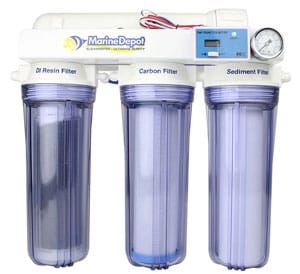
Here at Amazon.com
A good quality RO/DI (Reverse Osmosis/De-Ionized) unit will help to remove ALL of these pollutants with Silicate and Nitrate being among them. If you have filled your aquarium using water from the tap and added a dechlorinating solution like Seachem Prime, then your Diatom bloom could be quite severe.
Purchasing an RO/DI water filtration unit before you fill your aquarium will be one of the best investments you can make in the health of your tank. If you have already filled it, then I still highly recommend you getting one to help reduce your battle with all different algeas over the next few years!
You can find out more about them using the link at the bottom of the article.
How Long Do Brown Diatom Blooms Last In An Aquarium?
Like most food chains in mother nature, when there is an abundance of food, the consumer of that food source will rapidly populate to make the most of this food explosion. Diatoms are no different. As the silicate, and nitrate levels increase, so will your Diatoms population As the Diatoms consume these food sources, it will slowly diminish. Once the food source runs out, especially the silicate, the Diatoms die.
Diatom blooms typically last between 2-4 weeks in an aquarium. They will usually appear within the first months of an aquarium being set up. Manual removal with a gravel vacuum, increasing water flow, regular water changes, and chemical treament with Vibrant Aquarium Cleaner will reduce the duration.
Once the Diatoms are dead it will be the job of you and your filtration to remove the Diatom organisms and the bloom will dissipate.
Most Diatom Blooms appear to last anything from a few weeks to a few months. It all depends on the abundance of Nitrates and Silicates in your water. Every aquarium is different and two identically sized aquariums could have blooms that show up at different times in the first few months and could be very different in their coverage and longevity.
The more food source the aquarium provides, the longer the bloom will last. This is when it can go on for months! – Reduce their food sources and reduce the bloom!
To Finish
Diatom blooms are just a natural part of your aquarium maturing. They can be unsightly but its just mother nature doing her thing. By following some of the tips given above you can certainly reduce the severity of the outbreak and prevent it from reappearing but generally, a little bit of patience will soon see it run its course.
Further Reading
To follow on from a few things mentioned in this article you may find these more in-depth, on-topic articles useful:

